Volume 33, Number 2
June 2002


The Doings of the Department of Astronomy & Astrophysics
and the David Dunlap Observatory
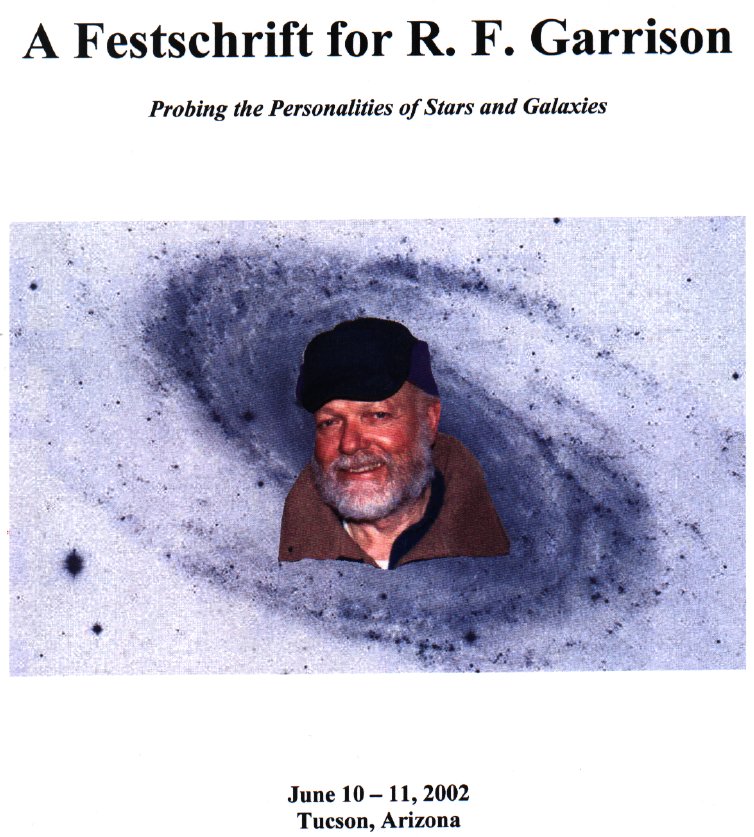
This image from a meeting celebrating the life and work of Bob Garrison
AND THE DAVID DUNLAP OBSERVATORY
ISSN 1209-0182
Co-Editors: Michael Allen & R.F. Garrison
Associate Editor: Christopher Tycner
Masthead Design: Brian Beattie
© Governing Council, University of Toronto, 2002
CONTENTS
- Editorial
- Cover Story: Bob Garrison Honoured in Tucson
- Comings and Goings
- Tales of success from our recent graduates, and more
- Congratulations
- Birth announcement from Rob Reid and Lynn Kovacs
- Meeting for Bob Garrison in Tucson
- Tom Bolton wins the Executive Director's Award of the IDA
- Chris Thomson wins Rutherford Medal
- GASA News
- A brief note from our graduate students
- Astronomy Education Items
- GTA Astro Network is re-established
- Science Education at UTM
- Education project in AST425
- Projects from AST299
- UT Mentorship Program
- The Small Radio Telescope project
- Research News
- Results from the DDO AGN monitoring program
- General Interest
- A Personal View of Combating Light Pollution
- New rose bushes at DDO
- Kevin Blagrave travels to NASA/Ames Research Center
- Marlene Cummins is appointed to an IAU working group
- Rob Reid travels to Haystack
- John Percy's travels
- On Measuring Radial Velocities at the DDO
- Easter and Passover (continued from the last issue)
- Library Annual Report (Highlights)
Editorial
by Michael AllenTwo of my great loves are music and astronomy. As I prepare to leave the country, I note that both these two are in a state of peril, and I would like to take this opportunity to express my concerns. Canada's top two orchestras, Toronto (TSO) and Montreal (OSM), are both leaderless: Jukka-Pekka Saraste left the TSO almost certainly as a result of a lengthy and damaging musicians' labour dispute, and Charles Dutoit recently resigned following a letter received from the musicians complaining about his dictatorial style on the podium. The TSO has been stuck in neutral gear, unable to find a suitable replacement for two seasons now; leaderless indeed.
Canadian astronomy is in the same danger, in that it is a small and basically leaderless community. Those few people who do speak out are doing so only to push their own selfish agendas. Our community of astronomers is too small for these tactics to be successful in the long run. After the disappointment following the incomplete funding for the LRP (a document reflective only of the division within the community), the formation of small-minded, narrow-in-scope "associations" is analogous to Achilles sulking in his tent while the Trojan war raged on around him. All that the future holds for us is further polarization of the community, more obvious perception of this polarization by those who hold the purse strings, and consequently less money for the community; this situation is a careless, forbidding, hopeless legacy to leave to the next generation.
One could hope that the injection of new blood into the community,
and the general expansion of the community, will lift us out of this
old mindset; a mindset of staking out territories, defending borders,
and attaching labels. It is a large burden placed upon the next
generation of astronomers. Let us hope they realize that "many hands
will lighten the load."
Cover Story: Bob Garrison Honoured in Tucson
by John Percy"Probing the Personalities of Stars and Galaxies". That was the topic of a special meeting, held 10-11 June 2002 in Tucson AZ, honouring the 66th birthday of Bob Garrison, and his four decades of research in astronomy. The meeting was organized by two of Bob's former PhD students -- Chris Corbally (Vatican Observatory) and Richard Gray (Appalachian State University) -- and was held in the historic Arizona Inn, one of the finest small hotels in the world. A "Bobeque" on the evening of 10 June was preceded by a partial eclipse of the sun. Viewing conditions: perfect! The scientific papers at the meeting highlighted Bob's work on spectral classification of stars -- a topic in which he is the world expert. They ranged from extending spectral classification to more extreme stars -- hotter, cooler, more luminous, less luminous. They dealt with spectral classification in the ultraviolet and infrared, and with developing automated techniques of spectral classification (such as neural networks) to deal with spectra obtained in massive surveys such as the Sloan Digital Sky Survey. Other papers touched on Bob's contributions to teaching, outreach, professional service and administration, including three decades directing the operations of the University of Toronto Southern Observatory. Upon his formal retirement, Bob was presented with a Lifetime Teaching Excellence Award by the Faculty of Arts and Science, University of Toronto -- the first-ever such award.
Bob's current research project, with Chris Corbally and Richard
Gray, is "The NStars Project". Its purpose is to produce homogeneous,
precise spectral types, basic physical parameters, and a measure of
the chromospheric activity for the 3600 dwarf and giant stars earlier
than M0 within 40 parsecs of the sun. This is part of NASA's mission
to search for planets around nearby solar-type stars. This project
connects beautifully with one of Bob's major teaching achievements.
Almost three decades ago -- well ahead of its time -- he co-created
(with Jack Dainty, Chair of the Dept of Botany) an astrobiology course
"Life on Other Worlds" which has been taken and appreciated by
thousands of undergraduate students at the University of Toronto. Now
he is deeply engaged in this field himself!
Comings and Goings
- Jennifer Karr (PhD 2002) is moving to a post-doc position at IPAC, in Pasadena.
- Tracy Webb (PhD 2002) is moving to a post-doc position at Leiden University, in Holland.
- Pengjie Zhang (PhD 2002) is moving to a post-doc position at FermiLab, Chicago.
- Wayne Barkhouse (PhD 2002) has completed his CLTA contract at the UofT and is moving to a post-doc at Harvard-CfA, where he will be working with CHANDRA data.
- Michael Allen (PhD 1999) has completed a 3-year CLTA/RA position at the UofT and is moving to a permanent position at Washington State University at Pullman, where he will be a Lecturer and co-ordinator of Project ASTRO, an ASP program that connects teachers, students, amateurs and professionals in astronomy.
- The Dept welcomes 3 new faculty members, who will begin their formal duties at various times between now and April, 2003: Chris Matzner, Yanqin Wu, and Marten van Kerkwijk. A very warm welcome to you all, and a sincere note of appreciation to Peter Martin for helping make available these positions.
- Chun Du, an engineering assistant at the DDO, has completed his contract work and left for new pursuits, in April of this year.
- The DDO/DAA is pleased to welcome two new technicians, Yakov Voronkov (Electronics), and Matt Rock (Maintenence and Computer Technician). They both join the DDO crew, currently consisting of Archie de Ridder (Operations Manager and Mechanical), Jim Thomson (Telescope Operator) and Heide DeBond (Telescope Operator). We welcome Yakov and Matt at the DDO and wish them all the best in the new workplace.
- Wojtek Pych (pron. Voitek Pych, with "ch" as in Scottish "loch") joined the Department on June 17, 2002 for a 2-year stay as a NATO-supported, NSERC-administred Post-Doctoral Fellow. Wojtek comes from the Copernicus Centre in Warsaw, Poland. He will work with Slavek Rucinski on subjects related to photometry of variable stars in large sky surveys, automatic classification of variables and on MOST data (when the satellite becomes operational in December 2002). Wojtek will have an office at the DDO and will share the downtown office with Slavek.
- Tracy Clarke (PhD 2000) has completed her Jansky Fellowship at NRAO Socorro and is moving to NRAO Charlottesville and a post-doc with Craig Sarazin.
- Gabriela Mallen-Ornelas (PhD 2000) has completed her post-doc at Princeton/Chile and is moving to a four-year fellowship at Harvard-CfA.
- Preethi Nair (PhD candidate) attended the CFHT Legacy Survey meeting at Mt. Washington, BC, from Feb 20 - 24.
Congratulations
- Congratulations to Rob Reid and Lynn Kovacs for
the birth of their second child, a boy. Rob writes:
- Lynn, Miranda and I welcome Damon Kepler Kovacs Reid, born at
12:30 this morning [Monday March 25] with a mass of 3950g and brownish
hair. Mother and son are doing very well after what was an easy*
labour.
*More so for me than for Lynn or Damon
- Bob Garrison's life and work was recently honoured at a meeting held in Tucson, Arizona. Please refer to the cover story.
- Tom Bolton is a winner of the 2002 Executive Director's Award of the International Dark Sky Association. See Tom's note in the General Interest section, below.
- Chris Thompson has won the 2002 Rutherford Medal. Dick
Bond writes (11Apr02):
I am very pleased to report that Chris Thompson, Associate Professor in CITA, has won the 2002 Rutherford Memorial Medal in Physics from the Royal Society of Canada. This award is for outstanding research in any branch of physics, with a preference given to an award to people under 40. Chris was a Senior Research Fellow at CITA in the 90s and we had the wisdom to draw him back from a faculty position in the US as a Professor in 2000.
LONG CITATION
Christopher Thompson, Professor, Canadian Institute for Theoretical Astrophysics, University of Toronto, has a reputation for originality, technical ability and deep physical insight unsurpassed by anyone in his age group in high-energy astrophysics. In particular, one of the major areas of development in astronomy now is gamma-ray bursts and Prof. Thompson is an international leader in the theory and the interpretation of the data. His proposal that "soft gamma ray repeaters" are highly magnetized neutron stars, which he dubbed magnetars, has been brilliantly confirmed by subsequent observations, and has stimulated much further theoretical and observational work. He is also known for the breadth of topics he covers, passing easily from cosmology to plasma physics and dynamos to black holes, neutron stars and supernovae to planetary systems, all topics on which he has written influential papers.
GASA News
By Kris BlindertThe biggest GASA news lately is not about our members at all, but about the new faculty hires. During the job search, GASA members chatted with (and noshed with) the candidates, and we were impressed. In fact, our subsequent GASA meeting was very confused: we didn't know whom to recommend! In short, we're collectively very pleased to welcome Yanqin, Marten, and Chris to the fold.
Other GASA activities centre around student engagements, both personal (congratulations to Rosemary and Gary on theirs) and professional, as some of our senior students wrap up their work and think to their futures outside of Toronto.
Lastly the champagne purchasers of GASA frantically prepare for a
rash of qualifying exams to begin soon. Good luck to Jenna, Lawrence,
Megan, and Preethi!
Astronomy Education Items
by John PercyAstronomy educators in the Greater Toronto Area re-established their "network" and carried out two notable projects this spring: a teachers' workshop on International Astronomy Day (hosted by U. of T. in partnership with the Science Teachers Association of Ontario), and a series of star parties across the GTA, including at the campus observatory, and at University of Toronto at Mississauga (aka Erindale Campus) where 500 visitors attended over two evenings. Members of the RASC Toronto Centre provided telescopes and volunteer help.
The Science Education Program at the University of Toronto at Mississauga, coordinated by John Percy, had another successful year. We added a 4th year project course, which two students took. One student Yasmine Aslam, working with John Percy, organized a Girl Guide Science Day at Erindale; over 130 girls took part in a variety of science-related activities, and received their Scientist Badge.
For the first time, a student in our AST425H project course completed a project in astronomy education research. Sarah Torrie developed a manual for astronomy outreach, with an assessment tool which graduate students and RASC members used to provide feedback and advice, which was incorporated into a final version. Sarah is a student in the Early Teacher Project at Scarborough, co-ordinated by Charles Dyer.
Two students participated in the Research Opportunities Program (AST299Y) this year: Gurtina Besla and Emily Redelmeier, both working with John Percy on pulsating red giants. Gurtina used Fourier analysis to identify the first three examples of small-amplitude red giants pulsating in multiple periods; these are consistent with low-order radial modes. Emily used wavelet analysis as an alternate way of looking for multiple periods in these stars.
The University of Toronto Mentorship Program held its annual Reception and Poster Session on 23 May. This program enables outstanding senior high school students to work on research projects with faculty members. Two students worked with John Percy, Matthew Coulter and Rebecca Dehmassi. Matthew used a form of autocorrelation analysis to search for new Beta Cephei stars in binary systems, using Hipparcos photometry. Rebecca tested the use of Hipparcos photometry for monitoring the period changes in known Beta Cephei stars. Lucy Zhang worked with Ue-Li Pen (CITA) on a project on gravitational lensing.
Michael Allen and Ernie Seaquist, with summer student JoAnne
Hosick, are in the process of installing the Small Radio
Telescope on the roof of the McLennan Labs, for use with AST325H
and other courses. This project was supported by a grant from the
Faculty's Instructional Initiatives Program, with matching funds from
the DAA.
The DDO AGN Monitoring Program
M. BlakeDavid Dunlap Observatory, Richmond Hill, Ontario
M. De Robertis, M. Argote, R. L. Fingerhut, H. K. Song, O. Vaduvescu
Dept. Physics and Astronomy, York University, Toronto, Ontario
History of the Project
The AGN monitoring program at DDO was conceived at a meeting in the fall of 2000 called by Slavek Rucinski regarding possible projects for DDO. At that meeting it was proposed that a number of circumpolar AGNs be monitored using the 1.9 m telescope, taking advantage of the principle competitive advantage of DDO over larger facilities, namely the ability to obtain observing time over months or years to study a single object. The 1.9 m telescope is ideal for long-term monitoring of astrophysical objects because projects requiring modest apertures but many nights to reap maximum scientific returns are difficult to perform at larger facilities. There were no expressions of interest in the project among the attendees at the initial meeting, and the project was temporarily shelved.
In the spring of 2001, collaborators were once again sought and an AGN monitoring group was formed. After discussions concerning the scientific objectives, an appropriate list of objects and instrumental setup were selected. The first dataset was obtained in September 2001. These data were essentially proof-of-concept observations intended to determine whether AGNs and QSOs could routinely be observed given the light-polluted skies of Richmond Hill. The initial observations indicated that the QSOs would be difficult to observe, but many bright AGNs (Seyfert galaxies) were easy targets. Since September 2001, regular monthly monitoring, weather permitting, has been performed on a subset of AGNs.
Scientific Goals
AGNs are a hot topic of current extragalactic research. Recent results suggest that the mass of a supermassive black hole at the center of a large galaxy scales with the mass of the parent galaxy. This likely indicates an intimate connection between the two. Understanding the physics of AGNs--how activity is initiated and maintained-- should help us understand the processes that lead to galaxy and structure formation.
In the 1990s, the International AGN Watch concentrated on monitoring a few objects, particularly NGC 5548, as intensively as possible over a wide wavelength range. It studied objects with IUE, HST, x-ray satellites, as well as dozens of ground-based optical telescopes. Some excellent work on "reverberation mapping" -- mapping the reaction of the emission-line regions/profiles to continuum variability -- emerged as a consequence of this campaign.
There are still many uncertainties related to AGNs. There are basically two types of line profiles in these objects; broad lines with velocity widths of 5-30,000 km/s, and narrow lines with widths of <2,000 km/s. It is believed that most objects' broad-line profiles are fairly stable over year time-scales, but this hasn't been verified conclusively and there are some objects whose broad-line profiles vary over several months and longer time-scales. Much can be learned by monitoring the profiles of a few well-chosen broad-line objects to search for variations on week-to-month-to-year time-scales. Based upon the importance and unresolved issues related to AGNs we decided to initiate a monthly, long-term (2-yr+) optical (spectroscopic) monitoring campaign of some AGNs in order to search for line-profile variability.
High-quality monitoring of this sample will provide a database that will be fairly unique. It is nearly impossible to get data sampled monthly over few-year time-scales for AGNs. We hope that by studying how the line profiles vary with time we will better understand the structure of the broad-line region, the nature of the emission-line clouds, and the fueling process in general.
Object Selection
Our object selection is limited primarily by the sensitivity of the guide camera, but there are still many interesting objects within the capabilities of the DDO 1.9 m telescope. The International AGN Watch group covered a number of galaxies, but they are currently only concentrating on NGC 5548 and 3C 390.3. They indicated that our contribution of spectra taken at regular intervals would be valuable. Table 1 lists the objects in our program. Column 1 gives the name of the object, Column 2 gives the redshift and Column 3 gives its apparent brightness.
| Object Name | z | Apparent Magnitude |
| NGC 7469 | 0.016 | 13.0 |
| Mrk 335 | 0.025 | 13.85 |
| NGC 1275 | 0.017 | 12.45 |
| Mrk 3 | 0.014 | 13.34 |
| Mrk 6 | 0.019 | 14.19 |
| NGC 3227 | 0.003 | 11.79 |
| NGC 3516 | 0.009 | 12.40 |
| Mrk 421 | 0.031 | 12.90 |
| NGC 4051 | 0.002 | 12.92 |
| NGC 4151 | 0.003 | 11.85 |
| NGC 5548 | 0.017 | 13.73 |
| NGC 5929 | 0.008 | 14.00 |
Observational and Data Reduction Procedures
Our observational procedure consists of using the 100 line/mm grating on the Cassegrain spectrograph, centered at 5700 Angstroms. This setup gives a dispersion of 3.6 Angstroms/pixel or a resolution of about 9-10 Angstroms, corresponding to about 450-500 km/s. Observations consist of taking two - three 20 minute exposures of each galaxy, with about 5 - 10 objects observed on each night depending upon the time of year and the weather conditions. The aim is to obtain observations of each galaxy a minimum of once per month. For this reason, we typically are awarded 4 nights per month at DDO. Some targets are observed seasonally, while several objects are circumpolar and will be observed throughout the year.
The data reductions are complicated by the fact that the CCD being used has poor sensitivity in the blue region of the spectra. The QE of this chip is >30% only between 5400-7500 Angstroms. As a result we are forced to take many flat-field images to reduce the noise in the blue region. In addition, we must take a short and long Fe-Ar spectrum for wavelength calibration. The long comparison exposures are used to obtain positions of the faint blue lines in the comparison lamp.
Results
We have now become familiar with the observational procedures, which have evolved somewhat as we gained experience. By June 20, 2002 we have obtained about 70 spectra of 10 AGNs. Figures 1 - 4 show spectra of Mrk 3, NGC 3227, NGC 4051 and NGC 4151. These are among the brightest objects in our study. The spectra were obtained on May 26/27, 2002, and are the sum of 2 exposures totalling 20 - 30 minutes of integration time and cover the wavelength region from 4500 to 7500 Angstroms. The wavelength scale is the observed wavelength scale and the spectra have not been de-redshifted. The important emission lines have been identified in each spectrum. The longest baseline we have covered is that for NGC 7469, for which we have a baseline from September 2001 to May 2002.
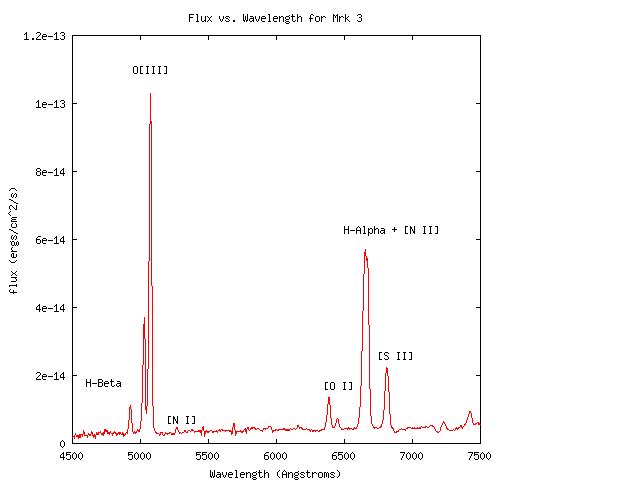 |
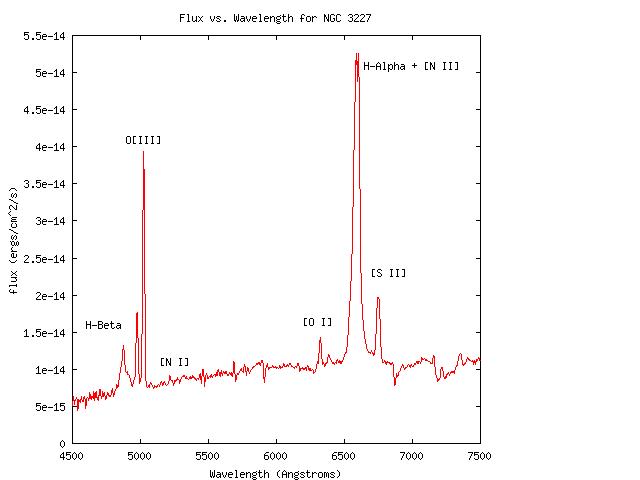 |
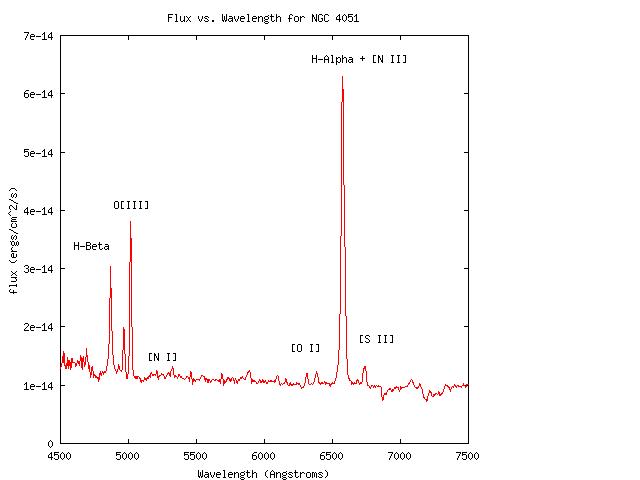 |
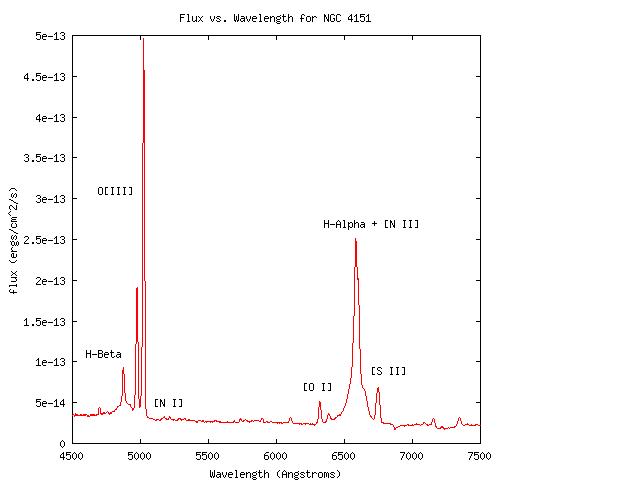 |
Future Work
We plan to carry out the current program for at least another two years, assuming the availability of observing time and manpower. We are just now getting to the point where the scientific returns are becoming apparent, and the next few months should prove exciting. Our techniques should continue to evolve as we gain experience and new science goals may be identified.
The DDO has obtained a new CCD camera which should greatly improve
our ability to obtain higher signal-to-noise ratio data in the blue
region of the spectra and should also be able to observe fainter AGNs
than is currently possible. We are currently improving our data
reduction techniques and ultimately we would like to perform the
reductions in near real-time (within a day after the observing
session) so that we can be aware of any major changes so as to alert
other groups. We have learned a lot in the first 8 months of this
project!
General Interest
A Personal View of Combating Light Pollution
(Ed. - this article is taken from the text of a message sent by Tom Bolton, requested by the International Dark Sky Association, in preparation for awarding to Tom the 2002 Executive Director's Award.)
I believe I was the first person in Canada to undertake a serious fight against light pollution. My work has been primarily with respect to the Town of Richmond Hill, Ontario, which surrounds the David Dunlap Observatory. I started fighting the growth of lighting in the Town on a development by development basis in 1972. By 1978, I had obtained the agreement of the Town and the Region of York to stop using metal halide and mercury vapour lamps. They also agreed to shield all new luminaires and gradually replace older luminaires with shielded ones.
The development-by-development fight continued until late 1986. However, this effort was proving to be very time consuming for myself, Town staff and Councillors, and the developers. Moreover, this latter group was getting tired of all of the bad publicity that I was able to generate in the local, Toronto, and national media. As a result, the Town agreed to pass a light pollution control by-law, and the University of Toronto agreed to pay for the cost of obtaining the required authorizing legislation from the Ontario Provincial Parliament. In the meantime, the Town agreed that I would be authorized to review and approve the lighting plans for all new developments until the by-law was in effect. I began this work in late 1986, and it continued until Spring, 1995.
I provided all of the technical input and participated in the writing of the Provincial authorizing legislation and the by-law. The former was passed in 1993, and the latter was passed and went into effect in 1995. Since then, I've provided occasional technical advice to Town staff who are responsible for enforcing the by-law.
Since 1972, I've taken advantage of every opportunity that was available to talk to the media about light pollution. I've appeared numerous times on local television, the national networks, CTV and CBC, and on CBC International. Numerous articles based on interviews with me have appeared in all of the major Toronto papers, some of which have national circulation, as well as the local paper, the Richmond Hill Liberal. This publicity has inspired the group that worked to create the Torrance Barrens Dark Sky Reserve in the Muskoka region of Ontario, and numerous other efforts by amateur astronomers to control light pollution in their communities in Ontario. I've served on the Light Pollution, Radio Interference, and Space Debris Committee of the Canadian Astronomical Society and the Light Pollution Committee of the Royal Astronomical Society of Canada. I've provided advice on developing light pollution control by-laws to the Dominion Astrophysical Observatory, the Observatoire de Mont Megantic, and faculty at York University in Toronto.
My accomplishments in Richmond Hill would not have been possible without the occasional assistance of Prof. Stefan Mochnacki, the support of the Observatory Directors, Professors Don MacRae, Don Fernie, and Ernie Seaquist, and eventually the support of University President, Prof. George Connell, who is an enthusiastic amateur astronomer.
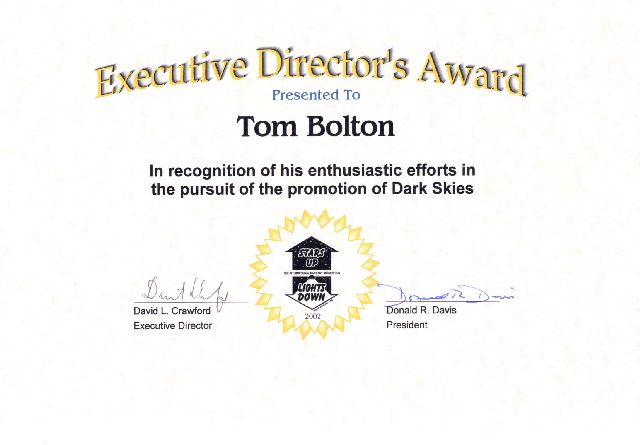 |
Click here for the web site of the International Dark Sky Association.
New rose bushes at DDO
I am pleased to inform you that Tom Karmo planted 8 rose bushes in the area of the dome and the DDO admin building. This is a very generous donation of his Mother, but Tom himself donated several hours of his work to professionally plant the bushes. Yakov helped Tom last evening (i.e., June 10, -ed.) to finish the planting.
This is not the first time that Tom has contributed to improving the general outlook of the DDO. I am aware of his generous donations in the last three years in planting flowers around the admin building. Some of them miraculously survived the onslaught of the local animals and our contracted (yet unprofessional) gardeners.
I would like to express my most sincere thanks to Tom, his Mother for their generosity and Yakov for his help.
(signed) Slavek
(Editor's note - we all thank Toomas for brightening up the grounds of the DDO. All travellers to DDO should take a moment to stop and smell the roses.)
Kevin Blagrave travels to NASA/Ames Research Center
This past April, I spent three weeks working with Bob Rubin at the Space Science Division of NASA/Ames familiarizing myself with HST STIS data of the Orion nebula. These STIS data allow us to look at spectral changes across the plane of the sky giving us insight into variations of such parameters as density, temperature, extinction and ultimately abundances. These data are an integral component of my thesis research. While in California, I also had the opportunity to attend a Center for Star Formation Meeting and was introduced to the extremely important field of laboratory astrophysics at the NASA Laboratory Astrophysics Workshop.
Marlene Cummins is appointed to an IAU working group
As a result of some activism regarding the new electronic-only format of the Publications of the Astronomical Society of Australia, Marlene Cummins struck up a friendly communication with the editor of that serial, Michelle Storey. Turns out Ms. Storey is also Chair of the IAU Working Group on Publishing and Marlene was subsequently appointed to that group as Library Consultant (non IAU members are not allowed to be members of IAU committees). The WG is, as one member put it, "an active group with an attitude". Marlene provided input into the most recent discussion of the committee and was warmly welcomed by several members.
Rob Reid travels to Haystack
On April 12 I gave a talk on my PhD topic, Smear Fitting, at Haystack Observatory (operated by M.I.T. and various other universities, see image below). Despite having read several of the eminent travel writer H.P. Lovecraft's reports on the area, I managed to take the not-quite-correct highway and was a few minutes late. Fortunately the audience was still receptive and it was quite stimulating to talk about Smear Fitting with a roomful of radio astronomers. Afterwards I had a quick tour of the facility, and got to see the famous radome from the inside. It's much bigger (37m, as opposed to the 25m outdoor dishes of the VLA) than it looks from its pictures, and the antenna almost fills the dome. Interestingly, the dome is not in a regular Buckminster Fuller arragement, but uses fivefold symmetry to avoid contaminating the polarized signal. Major initiatives at the observatory now are LOFAR, a 327 MHz array for detecting primoridial deuterium, and new recorders for VLBI.
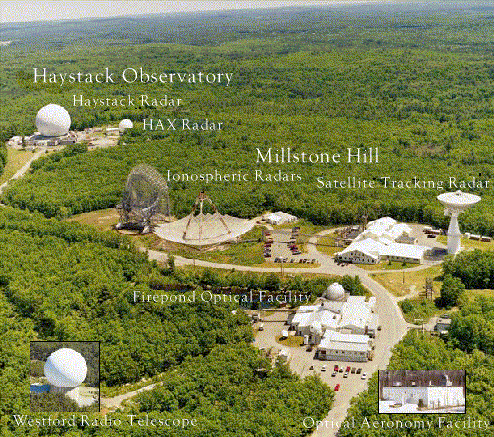
John Percy's travels
John Percy addressed the Senior Alumni on 2 April, on the topic of "Frontiers of Astronomy", and gave a similar presentation to the University Arts Women's Club on 18 April.
John Percy visited North Bay on 15-16 April as the first CASCA-Westar Visiting Lecturer. This new program, patterned after the AAS' Harlow Shapley Visiting Lectureship, brings astronomy to centres in Canada without professional astronomy facilities. He gave two lectures to grade nine students totalling 700 -- most of the grade nine students in the North Bay area. The topic was "Planets Around Other Stars"; it began with the bright solar system planets which were then visible in the evening sky; then moved on to exoplanets, highlighting Canadians' contributions to this field. He also gave a public lecture on the same topic, to over 100 people. He met with about 30 teachers, leaving behind resources to support the teaching of the new astronomy units in the school curriculum.
John Percy attended the CASCA 2002 meeting in Penticton, where he presented a report on the Canadian astronomy education and public outreach program, and also gave a paper with Gurtina Besla on her AST299Y project on multiple periods in pulsating red giants. A highlight of this meeting was a one-day workshop for 60 graduate students, on education and outreach. This workshop was organized by the CASCA Graduate Student Committee.
John Percy also attended the RASC General Assembly in Montreal, 18-19 May, in part to promote the national education and outreach program, in which the RASC is a partner. At that meeting, Bob Garrison completed his two-year term as RASC National President.
On Radial Velocities Measured with the DDO 1.88 m Telescope Cassegrain Spectrograph
Submitted by Tom Bolton
From time-to-time I get requests for archival radial velocity measures from Roger Griffin. I recently provided him with some data for two stars. One of the stars had a mean velocity published by R. K. Young based on four prism spectrograms, and I found an additional nine measures done from 8 A/mm spectrograms using the PDS microdensitometer. Following are Griffin's comments on these data, which I think are very flattering to DDO.
The DDO data are very helpful for HD 39743 (HR 2054), and I am particularly grateful to you for volunteering all those additional velocities of whose existence I was of course unaware. They fit my orbit very well, and reduce the standard deviation of the period by a factor of three, as well as making modest improvements in the other elements. I found that both your own nine measures, and also (rather to my surprise) Young's four, seemed to show a standard error that is only twice what I get from my new(ish) radial-velocity instrument here, so I weighted them 1/4; many 'old' observations need a far smaller weighting than that. In assessing their uncertainties, I allowed myself to reject one of your nine observations, which had a residual quite out of keeping with the others. I added 0.8 km/s to Young's observations, which is the value that I take to represent what - though I never call it so in print! - is probably the error of my own zero-point. To yours I added 1.8, which could be viewed as meaning that, as you supplied them, they were probably about 1.0 km/s below the IAU zero-point, which is only 1 standard deviation away from the number you gave, so I feel that that is all right.
Best wishes, Roger
Easter and Passover
by Michael Allen
In the previous issue of the Doings (Feb 02), I wrote about some of the questions received through the info@astro mail alias, one of which concerned which years the date of Passover falls on the Thursday before Easter Sunday, thereby repeating what is fabled to have happened. Easter calculators available on the web (through the USNO, for example) report the date of the first full day of Passover. However, Jewish tradition has it that the day begins at sundown. Therefore, to properly make the calculation, one must use Passover calculators to find when the first full day of Passover is the Friday before Easter Sunday (and therefore, the Passover meal occurs Thursday night; recall that the Last Supper was a Passover meal).
The calculation was performed again, correctly, to discover that
this Friday-Sunday sequence occurs only twice, in the years 1633 and
1785. I allowed the calculation to test the next five thousand years,
after which I became bored when there were no positive results.
Library Annual Report (Highlights)
By Marlene CumminsThe Library spent $35,359, slightly over budget ($35k). Last year the library spent only $22k, which was unusually low. Most of the increase over last year was in a higher average price per book purchased (now $117).
We catalogued 212 new books, 10 new serials, and 73 new slides (3 sets), among other things. As before, most of these new books must be piled on the floor - we've run out of space.
Progress continues in the project to improve the web catalog database (there are many duplicate, incorrect and missing records in the web version).
About 190 department theses were added to the catalog database (in the library and on the web) and on the Library's thesis website listing- this section is now complete and correct. Our earliest thesis is dated 1932.
A new library webpage 'Electronic Books at UofT' was created.
Nine books were purchased for DDO this year. The librarian went to DDO about once a month.
Harvard has a large grant to digitize many serials, including observatory publications; we loaned several missing issues to that project.
We have downloaded and printed an occasional book before, but this year we obtained most of a series of NGST books in that way.
Some web items were catalogued and integrated into the catalog (for the first time since the first years of the web, when websites were collected and mounted- but using a separate database). A collection policy was formulated for this activity. This policy is available on the web:
http://www.astro.utoronto.ca/internal/web_collection_policy.html.
A new header was designed for the department website
A report on changes in library environment and services was prepared for the Chair: Future of the Astronomy and Astrophysics Department Library
Photocopies of conference proceedings tables of contents and updates to the Astronomy Book and Software Reviews were sent to ADS for inclusion in their database.
Details of these items and much additional information can be found
in the complete annual report, available in the Library.